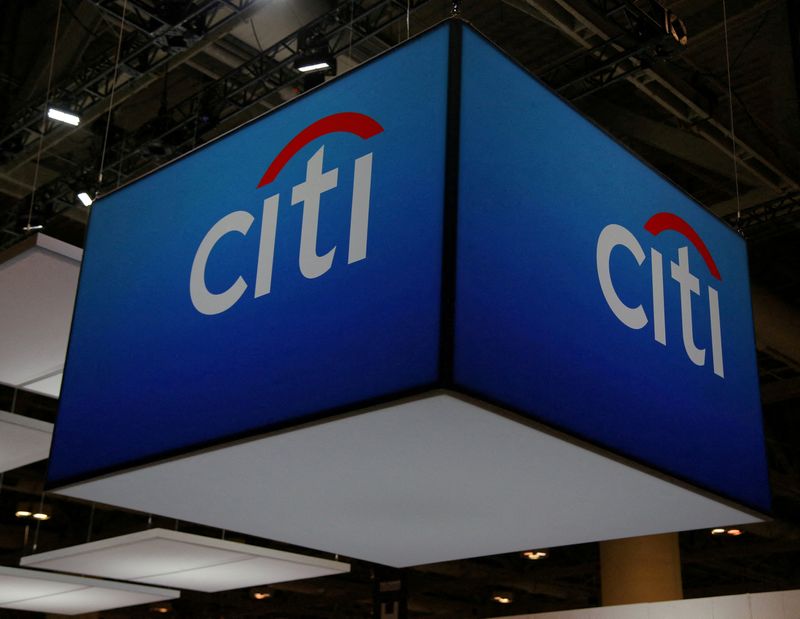Tatiana Bautzer and Manya Saini
(Reuters) – Citigroup Inc. said on Friday its second-quarter profit beat Wall Street expectations on a 60 percent rise in investment banking revenue and a gain in its services division, but its shares fell 2.9 percent on investor concerns about expenses and market share.
The third-largest U.S. bank reported profit of $1.52 a share for the three months ended June 30. Analysts had expected $1.39, according to LSEG data.
Warren Cornfeld, senior vice president of financial institutions at Moody’s Ratings, said the results reflected Citi’s struggles to meet its target of 11-12 percent shareholder return, down from 7.2 percent in the second quarter.
“The results again reflect the strength of the services business. However, Citi faces challenges in gaining market share and reducing costs in other segments.”
The strong results came two days after U.S. regulators fined Citi $136 million for “inadequate” efforts to resolve data management issues identified in 2020. Regulators also demanded that Citi show it was dedicating sufficient resources to those efforts.
Citi had already booked penalties and additional investments related to its data work in the second quarter based on its own cost estimates.
Citi’s Chief Financial Officer Mark Mason said in a conference call with reporters that the bank has not yet agreed with regulators on its resource allocation plan for the increased regulation and that details of any agreement would be confidential for supervisory purposes.
In areas where regulatory work is likely to be delayed, Citi will determine the root cause and determine whether further technology spending, additional applications or platform tweaks or additional staffing are needed, Mason added.
The stock reversed gains in premarket trading and fell 3.3%.
Citi “had a strong quarter, driven by better-than-expected trading revenue in the second half of the quarter,” Oppenheimer analyst Chris Kotowski wrote in a client note. He added that “the disturbances related to various civil penalties and the ongoing restructuring were relatively minor.”
Chief Executive Jane Fraser is pushing ahead with sweeping reforms aimed at improving the bank’s performance, cutting costs and simplifying much of the business. As part of the turnaround, Citi aims to cut 20,000 jobs over the next two years.
Second-quarter revenue was $20.1 billion, up 4% from the same period a year ago, helped by a $400 million gain on the conversion and partial sale of Visa shares in May.
Citi now breaks down revenue separately for five businesses that were previously housed under broader divisions: Services, Markets, Banking, U.S. Consumer Banking and Wealth.
The new structure is part of Fraser’s efforts to cut bureaucracy and increase profits, and under it, divisional leaders will report directly to the CEO.
Investment banking fees rose 60% in the second quarter to $853 million. The surge came as a long period of sluggish deal activity across the industry finally showed signs of a real recovery. The increase helped drive a 38% increase in banking revenue, which included corporate lending, to $1.6 billion.
“We continued to see strong debt issuance this quarter, strong M&A activity, the IPO market is showing signs of recovery and we have a very strong pipeline,” Mason said on a conference call.
“We expect the interest rate environment and funding markets to be accommodative. M&A could play a larger role in the second half of the year.”
Citi earlier this year hired Viswas Raghavan, a veteran of JPMorgan Chase & Co., as head of its banking division, and Mr. Fraser has high hopes for Mr. Raghavan, who is tasked with revitalizing the multinational business unit.
Services revenue increased 3% to $4.7 billion. This division is focused on the company’s flagship business, financial and trade solutions, which saw revenues flat at $3.4 billion for the quarter. The business processes $5 trillion in payments per day for multinational companies across 180 countries.
Fraser and other executives touted the services strategy at an investor day last month at the bank’s New York headquarters.
Markets revenue increased 6% to $5.1 billion behind a 37% increase in equity trading revenue.
Guidance plus costs
Reported operating expenses for the quarter fell 2% to $13.4 billion as the bank restructured to streamline its structure and save money.
But the decline in operating expenses was offset by penalties for failing to comply with regulatory penalties known as consent orders dating back to 2020, and investments in remediation work.
Mason said Citi now expects full-year costs, excluding regulatory fines, to be at the high end of its previously expected range of $53.5 billion to $53.8 billion.
Rival JPMorgan Chase & Co. reported an increase in second-quarter profit on Friday, while Wells Fargo’s net income fell and interest income fell short of expectations.
Citi’s asset management division, a key part of Fraser’s growth strategy, has yet to see significant growth, with revenue rising 2 percent to $1.8 billion in the quarter.
The bank’s U.S. consumer banking revenue rose 6% to $4.9 billion, mainly due to growth in branded cards.
Focus on turnaround
Analysts say 2024 will be a year of transition for City as Fraser’s restructuring slims down the club.
Investors have welcomed the initiative, sending Fraser Bank shares up 28% this year, far outperforming its closest rivals JPMorgan and Bank of America and the overall stock market.
Still, Citi has faced other regulatory challenges in recent days, including regulators deeming its so-called living will, which details how it would be wound up in the event of bankruptcy, “insufficient.”
(Reporting by Tatjana Bautzer in New York and Manya Saini in Bengaluru; Editing by Ranan Nguyen, Shaunak Dasgupta and Nick Zieminski)


